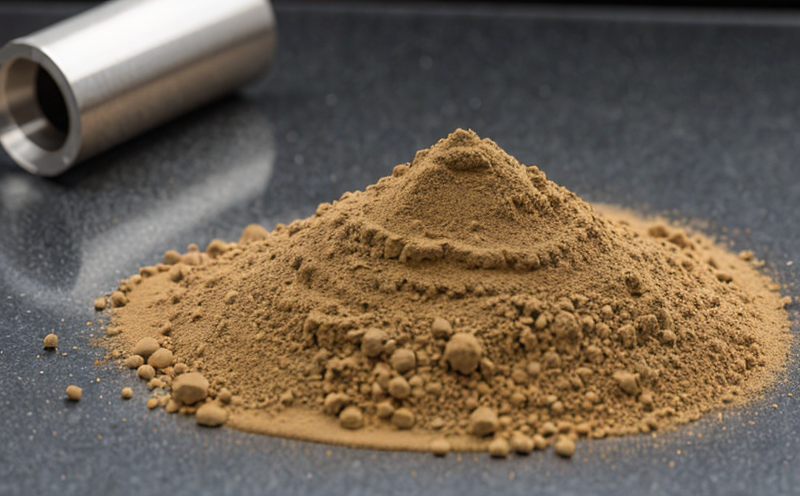ISO 15327 Chemical Composition Testing of Powders
The ISO 15327 standard provides a comprehensive approach to ensuring the quality and consistency of powder materials used in additive manufacturing (AM) and 3D printing processes. This test is crucial for industries where precision and repeatability are paramount, such as aerospace, medical devices, and automotive sectors.
The process involves meticulous chemical analysis of powders to ensure they meet the specified composition requirements outlined by the standard. The primary goal is to identify any deviations from the expected composition that could impact the final product's performance or compliance with regulatory standards.
During this testing procedure, various analytical techniques may be employed depending on the specific requirements and properties of the powders being analyzed. Common methods include inductively coupled plasma mass spectrometry (ICP-MS), X-ray fluorescence spectroscopy (XRF), and energy-dispersive X-ray spectroscopy (EDS). Each method has its strengths, allowing for precise determination of trace elements down to parts per million levels.
Specimen preparation is critical when conducting ISO 15327 chemical composition testing. Homogeneous samples must be prepared by thoroughly mixing the powder to ensure uniform distribution across all test areas. This ensures that any analysis performed reflects the true average composition rather than localized variations within the batch.
The equipment used for these tests includes state-of-the-art analytical instruments capable of detecting even minute quantities of elements present in metallic and non-metallic powders. These instruments provide accurate, reliable data which forms the basis upon which decisions about material suitability are made.
Acceptance criteria for materials tested under ISO 15327 vary based on intended application but generally require close adherence to specified elemental ranges. Compliance with these limits helps prevent issues related to poor mechanical properties or potential health hazards associated with certain impurities.
- Environmental Impact: Ensuring compliance through rigorous testing reduces waste generation during production processes by minimizing the use of substandard raw materials.
- Sustainability: By providing reliable data on material composition, this test supports sustainable practices in manufacturing industries that rely heavily on additive technologies.
- Economic Benefits: Accurate identification of impurities allows manufacturers to make informed decisions regarding sourcing and quality control measures reducing costs associated with rework or scrap.
In summary, ISO 15327 chemical composition testing plays a vital role in maintaining high standards across additive manufacturing processes. It ensures consistency in material properties while promoting sustainable practices that benefit both the environment and business operations.
Why Choose This Test
Selecting ISO 15327 chemical composition testing for your powder materials offers numerous advantages, particularly if you're involved in industries where precision is critical. One key reason to choose this test is its ability to provide accurate and reliable data on the elemental makeup of powders used in additive manufacturing processes.
Accurate knowledge of material composition enables better decision-making throughout the supply chain. From sourcing high-quality raw materials to ensuring consistent end-product performance, having precise information helps mitigate risks associated with substandard components. This level of assurance is especially important given the stringent quality requirements imposed by regulatory bodies worldwide.
Another significant advantage lies in the enhanced reliability that comes from adhering strictly to ISO 15327 guidelines during testing. By following these internationally recognized standards, you demonstrate commitment to excellence and build trust with customers who demand top-tier performance from their suppliers. This can translate into competitive advantages through improved brand reputation and customer satisfaction.
Moreover, choosing this test ensures compliance with industry best practices while staying ahead of emerging trends in additive manufacturing technology. As new materials and processes continue to evolve rapidly within the sector, maintaining up-to-date knowledge is essential for staying relevant. The rigorous testing protocols defined by ISO 15327 help maintain a robust foundation upon which further innovations can be built.
Finally, selecting ISO 15327 chemical composition testing allows businesses to differentiate themselves in competitive markets. In an era where quality and reliability are key factors influencing purchasing decisions, having access to accurate test results gives companies a clear edge over competitors who may not prioritize such stringent standards.
Competitive Advantage and Market Impact
The implementation of ISO 15327 chemical composition testing can significantly enhance a company's competitive position in the global market. By demonstrating adherence to this internationally recognized standard, businesses can establish themselves as leaders in quality assurance within their respective industries.
Customers increasingly seek partners who not only deliver excellent products but also provide transparency and reliability throughout the supply chain. A robust ISO 15327 compliance program sends a strong message about your commitment to delivering premium materials that meet industry benchmarks.
In terms of market impact, adhering to these stringent testing protocols can open doors to new markets and partnerships. Many international buyers specify certain standards as prerequisites for doing business, making it essential for suppliers to comply with such requirements.
Furthermore, maintaining ISO 15327 certification demonstrates forward-thinking leadership in embracing emerging technologies like additive manufacturing. It positions your organization at the forefront of innovation while fostering long-term growth prospects.
In conclusion, integrating ISO 15327 chemical composition testing into your operations offers tangible benefits that extend beyond mere compliance. It enhances product quality, fosters trust among stakeholders, and drives sustainable practices—all contributing to a stronger market presence and enduring success.





